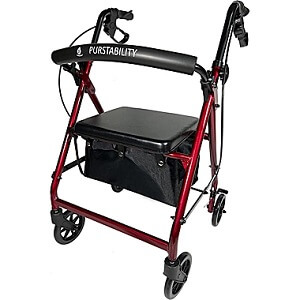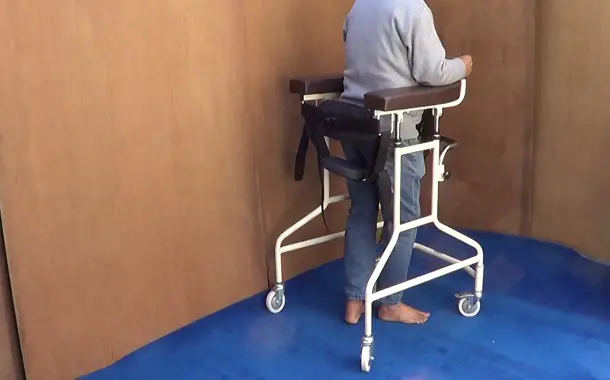How Much Does an Adult Walker Cost?
The adult walker is an aid device for walking, extremely useful for patients in periods of medical recovery, as well as for elderly people, who have balance problems and who cannot support themselves while walking. Adult walkers can help older adults lead an active lifestyle by providing a safe way to stay mobile.
When buying a walker for yourself or a loved one, it’s important to choose a walker with features that fit your needs. Since walkers come in a variety of styles and price ranges, doing your homework before you buy can help make the process easier.
How Much Does an Adult Walker Cost?
Depending on the type and the brand, the cost of an adult walker would be anywhere between $40 and $350.
For instance, you can find walkers for the elderly at Walmart at prices that start at around $30 and go up to $160.
The highest-rated sellers on Amazon retail adult walkers at prices that range anywhere between $35 and $50.
In the table below you will find the average cost of some of the most common types of adult walkers.
| Type | Description | Price Range | Weight Capacity | Walker Weight | Foldability | Extra Features |
|---|---|---|---|---|---|---|
| Heavy Duty | Bariatric rolling walkers designed for strength, with 0-4 wheels, accommodating up to 500 pounds. | $55 to $185 | Up to 500 lbs | 15-25 lbs | Yes | Optional seat, pouch |
| Knee Walker | 3 or 4 wheel walking aid, allowing the user to prop their knee while propelling with the other leg, ideal for those who can’t put weight on a leg and/or knee. | $75 to $200 | Up to 300 lbs | 20-30 lbs | Yes | Adjustable knee pad |
| Rolling | Also known as rollator or wheeled walker, featuring a frame and 3 or 4 larger wheels, typically heavier than a standard walker. | $55 to $175 | Up to 350 lbs | 15-20 lbs | Yes | Seat, pouch, brakes |
| Standard (basic) | Traditional walker without wheels, reducing friction for easier movement, providing support and stability, most popular choice for those who struggle with wheeled versions. | $35 to $85 | Up to 300 lbs | 6-10 lbs | Yes | None |
| Two-in-one Walker-Wheelchair | Walker and wheelchair combination, with a flip-backrest to convert between the two, suitable for individuals who can walk short distances. | $150 to $250 | Up to 250 lbs | 20-30 lbs | Yes | Built-in seat |
With so many options, it’s a good idea to talk to your doctor or physical therapist before purchasing a walker. They can help you make the right decision.
You can also work with an assistive technology specialist. This is an expert that helps people choose and use customizable devices.
Which are the additional expenses?
Depending on your circumstances, you may need popular walker accessories like an attachment basket or a tote bag that attaches to the back that costs around $25, grip covers that cost around $25 and glide covers that cost another $15.
Adult walker overview
The first adult walkers appeared around the 1950s and were of fixed height, after a few years adult walkers with wheels also appeared.
Modern adult walkers are adjustable in height, being able to be adapted for a wide range of heights, depending on the comfortable position of each user. The position indicated in the use of walkers is a slightly inclined one (from the waist) to ensure the stability of the device-patient assembly, as well as to facilitate blood circulation in the arms.
You might also like our articles on the cost of a hospital bed, wheelchair, or wheelchair rental.
Some adult walkers can have wheels on the front legs, which require a little more stability and strength from the patient.
There are also adult walkers with wheels on all four legs or rubber or textile stops for interior wooden or stone surfaces.
An alternative version of the adult walkers is the rollators, which are basically walkers with large wheels and accessories: luggage basket, hand brakes, and wheel locks. Usually, rollators have four wheels, but there are also rollers with three wheels.
Types of adult walkers
The most common walkers for adults include:
- standard walker;
- two-wheeled walker;
- four-wheeled walker (also known as a “rollator”).
Among the adult walkers, dedicated to the elderly, there are versions of walkers with a seat, tray, and basket for small purchases, ideal for people who want to continue to have an active life.
Important things to consider
 Choose walking walkers according to the needs of the user. For example, in the case of a person with a low degree of mobility, an assistive walking frame with front wheels is indicated that allows pushing forward, without requiring lifting and therefore additional effort.
Choose walking walkers according to the needs of the user. For example, in the case of a person with a low degree of mobility, an assistive walking frame with front wheels is indicated that allows pushing forward, without requiring lifting and therefore additional effort.
If you have unsteady motion and need to carry a significant amount of weight on your walker, the University of Arizona Center on Aging says the standard walker is the best.
If you have an unsteady gait but don’t need to carry a lot of weight on a walker, a two-wheel stand is recommended. And if you just need a walker to help you balance, a four-wheeler is a great place to start.
Regardless of the models you choose, the adult walkers are made of resistant materials and provide the necessary support for patients with mobility difficulties, favoring the maintenance and progressive recovery of walking during the post-traumatic rehabilitation phase or in the postoperative period.
Take into consideration buying a walker that you can easily fold and transport if you plan on traveling outside of the house frequently.
What are the main advantages of an adult walker?
For people with reduced mobility, as well as for the elderly, the use of an adult walker is extremely useful, because it offers them the mobility and security lost with advancing age. Also, it:
- helps to stabilize the balance, avoiding possible falls;
- they are made of light, quality materials, so as not to make it difficult for the user to relax;
- reduces fatigue and pain caused while walking;
- offers more confidence and autonomy in movement;
- distributes body weight.
Tips for saving money
Take into consideration purchasing a slightly used adult walker that you can find on eBay. Even though you may have to pay for delivery, you can still find a walker in great condition for less than $30. You could be able to save up to 40% or even more by buying a used or even refurbished walker.
As long as it is prescribed by your doctor, Medicare Part B will cover the cost of a walker.


Leave a Reply
Want to join the discussion?Feel free to contribute!